
Daniel Chester French was an American sculptor of the late nineteenth and early twentieth centuries. He is best known for his 1874 sculpture The Minute Man in Concord, Massachusetts, and his 1920 monumental statue of Abraham Lincoln in the Lincoln Memorial in Washington, D.C.

Karl Theodore Francis Bitter was an Austrian-born American sculptor best known for his architectural sculpture, memorials and residential work.
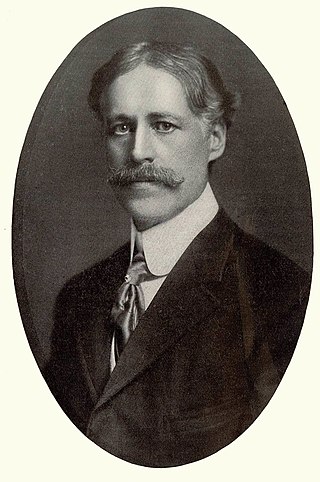
William Ordway Partridge was an American sculptor, teacher and author. Among his best-known works are the Shakespeare Monument in Chicago, the equestrian statue of General Grant in Brooklyn, the Pietà at St. Patrick's Cathedral in Manhattan, and the Pocahontas statue in Jamestown, Virginia.

Cyrus Edwin Dallin was an American sculptor best known for his depictions of Native Americans. He created more than 260 works, including the Equestrian Statue of Paul Revere in Boston; the Angel Moroni atop Salt Lake Temple in Salt Lake City; and Appeal to the Great Spirit (1908), at the Museum of Fine Arts, Boston. He was also an accomplished painter and an Olympic archer.

The Chicago Cultural Center, opened in 1897, is a Chicago Landmark building operated by Chicago's Department of Cultural Affairs and Special Events. The Cultural Center houses the city's official reception venue, where the Mayor of Chicago has welcomed presidents, royalty, diplomats, and community leaders. It is located in the Loop, across Michigan Avenue from Millennium Park.
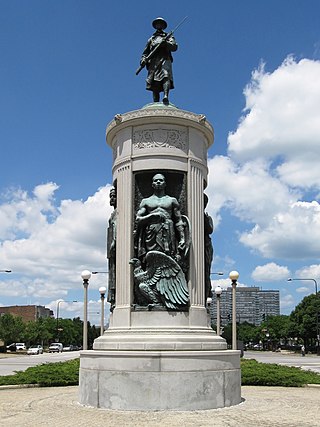
Erected in 1927, the Victory Monument, is a bronze and granite sculptural monument, based on a concept by John A. Nyden, and sculpted by Leonard Crunelle. It was built to honor the Eighth Regiment of the Illinois National Guard, an African-American unit that served with distinction in France during World War I. It may be the only memorial statue dedicated to African-American soldiers of the Great War.

Corning Fountain is a fountain with sculpture located in Bushnell Park, Hartford, Connecticut.

Richard Henry Park was an American sculptor who worked in marble and bronze. He was commissioned to do work by the wealthy of the nineteenth century. He did a marble bust of John Plankinton, an astute businessman who founded the meat industry in Wisconsin and was "Milwaukee's foremost citizen."

Major General John A. Logan, also known as the General John A. Logan Monument and Logan Circle Monument, is an equestrian statue in Washington, D.C., that honors politician and Civil War general John A. Logan. The monument is sited in the center of Logan Circle, a traffic circle and public park in the Logan Circle neighborhood. The statue was sculpted by artist Franklin Simmons, whose other prominent works include the Peace Monument and statues in the National Statuary Hall Collection. The architect of the statue base was Richard Morris Hunt, designer of prominent buildings including the Metropolitan Museum of Art in New York City and The Breakers in Newport, Rhode Island. Prominent attendees at the dedication ceremony in 1901 included President William McKinley, members of his cabinet, Senator Chauncey Depew, Senator Shelby Moore Cullom, and General Grenville M. Dodge.

The George Gordon Meade Memorial, also known as the Meade Memorial or Major General George Gordon Meade, is a public artwork in Washington, D.C. honoring George Meade, a career military officer from Pennsylvania who is best known for defeating General Robert E. Lee at the Battle of Gettysburg. The monument is sited on the 300 block of Pennsylvania Avenue NW in front of the E. Barrett Prettyman United States Courthouse. It was originally located at Union Square, but was removed and placed in storage for fourteen years before being installed at its current location. The statue was sculpted by Charles Grafly, an educator and founder of the National Sculpture Society, and was a gift from the state of Pennsylvania. Prominent attendees at the dedication ceremony in 1927 included President Calvin Coolidge, Governor John Stuchell Fisher, Secretary of the Treasury Andrew W. Mellon, and Senator Simeon D. Fess.
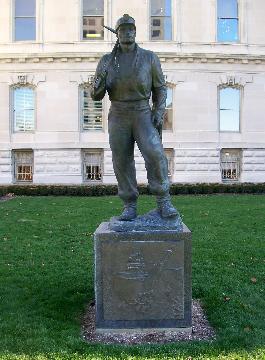
Coal Miner is a public artwork by Polish American artist John J. Szaton (1907–1966) which is located in two US State capitals; the original, commissioned in 1963 in Springfield, Illinois, as well as a copy on the west lawn of the Indiana State House in Indianapolis The statues commemorate coal miners who had lost their lives in those states' mining industry. The 7-foot (2.1 m) tall statue rests on a 3-foot (0.91 m) square, granite base supported by a cement foundation that is 4–6 inches (100–150 mm) thick.
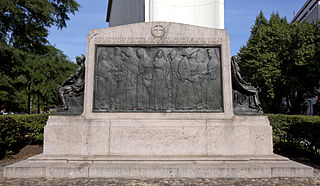
Nuns of the Battlefield is a public artwork made in 1924 by Irish artist Jerome Connor, located at the intersection of Rhode Island Avenue NW, M Street, and Connecticut Avenue NW, in Washington, D.C., United States. A tribute to the more than 600 nuns who nursed soldiers of both the Union Army and the Confederate States Army during the American Civil War, it is one of two monuments in the District that mark women's roles in the conflict. It is a contributing monument to the Civil War Monuments in Washington, D.C., listed on the National Register of Historic Places. In 1993, it was surveyed for the Smithsonian Institution's Save Outdoor Sculpture! program.

Arthur Putnam was an American sculptor and animalier who was recognized for his bronze sculptures of wild animals. Some of his artworks are public monuments. He was a well-known figure, both statewide and nationally, during the time he lived in California. Putnam was regarded as an artistic genius in San Francisco and his life was chronicled in the San Francisco and East Bay newspapers. He won a gold medal at the 1915 San Francisco world's fair, officially known as the Panama–Pacific International Exposition, and was responsible for large sculptural works that stand in San Francisco and San Diego. Putnam exhibited at the Armory Show in 1913, and his works were also exhibited in New York, Philadelphia, Chicago, Paris, and Rome.

John J. Boyle was an American sculptor active in Philadelphia in the last decades of the 19th century, known for his large-scale figurative bronzes in public settings, and, particularly, his portraiture of Native Americans.

Eternal Silence, alternatively known as the Dexter Graves Monument or the Statue of Death, is a monument in Chicago's Graceland Cemetery and features a bronze sculpture of a hooded and draped figure set upon, and backdropped by, black granite. It was created by American sculptor Lorado Taft in 1909.

A Signal of Peace is an 1890 bronze equestrian sculpture by Cyrus Edwin Dallin located in Lincoln Park, Chicago. Dallin created the work while studying in Paris and based the figure on a member of Buffalo Bill's Wild West Show, which he attended often. He exhibited the original plaster version of the sculpture at the Paris Salon of 1890, where it won honorable mention.
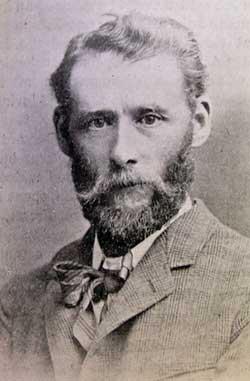
Hamilton Thomas Carlton Plantagenet MacCarthy was one of the earliest masters of monumental bronze sculpture in Canada. He is known for his historical sculptures, in particular his Pierre Dugua, Sieur de Mons at Annapolis Royal, Nova Scotia (1904) as well as Samuel de Champlain overlooking Parliament Hill on Nepean Point, Ottawa (1915), next to the National Gallery of Canada. His monument to the Ottawa volunteers who died in the South African War (1902) was moved to Confederation Park in 1969 after several moves. Other works include that of Ottawa mayor, Samuel Bingham, in Notre-Dame Cemetery in Vanier.
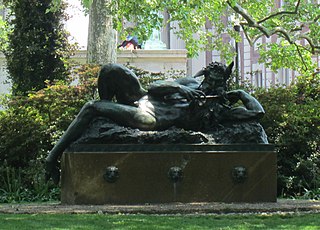
The Great God Pan is a bronze sculpture by American sculptor George Grey Barnard. Since 1907, it has been a fixture of the Columbia University campus in Manhattan, New York City.
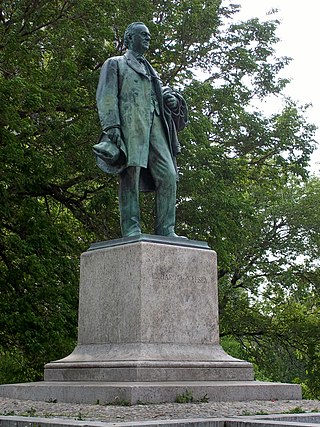
The Richard J. Oglesby statue is a monumental statue of Richard J. Oglesby in Chicago, Illinois, United States. Dedicated in 1919, the statue was designed by Leonard Crunelle and located in the city's Lincoln Park.

The Ulysses S. Grant Monument is a presidential memorial in Chicago, honoring American Civil War general and 18th president of the United States, Ulysses S. Grant. Located in Lincoln Park, the statue was commissioned shortly after the president's death in 1885 and was completed in 1891. Several artists submitted sketches, and Louis Rebisso was selected to design the statue, with a granite pedestal suggested by William Le Baron Jenney. At the time of its completion, the monument was the largest bronze statue cast in the United States, and over 250,000 people were present at the dedication.





















